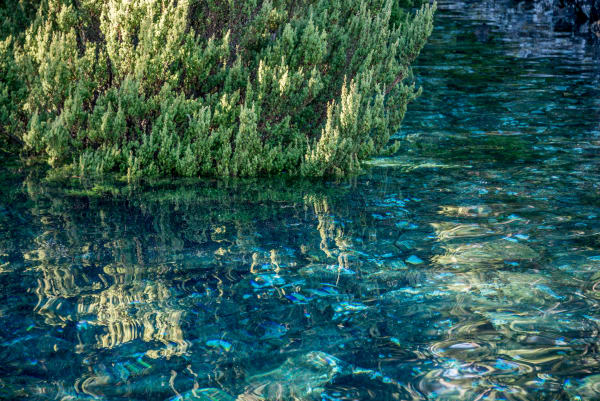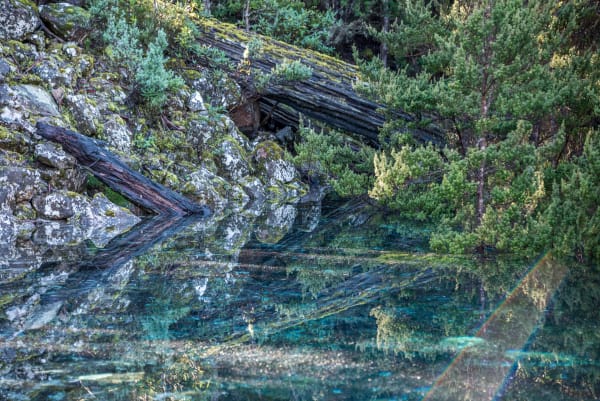Thunderstorms trained in from kunanyi’s gloomy bulk, like wilful, sugar-drunk children queuing to whack a piñata. Each assault more eager than the last, tearing limbs, downing powerlines, and pouring water into the creases and folds of the land. Lightening strobed, giving brief illuminations to the destruction.
As yet another storm rolled down into the Derwent estuarine, Hobart Rivulet burst its levies, a coffee torrent spilling from its ersatz channel to find its ancient course. Irreverent to man’s corruptions, it flowed down main roads, and through buildings, carrying cars as flotsam to find its lost ingress to the Derwent.
A few days after the tempest, its legacy is a sepia blush of fresh water in the Derwent, and roads strewn with debris and the muddy stains of flood. And, in the dumping of three months of rain – a whopping 236.2mm – in just 24 hours on kunanyi, came the promise of one of Tasmania’s most elusive, yet worst-kept secrets: a fabled topaz-blue lake that appears on the mountain’s southern boulder fields only after very heavy rains. The disappearing tarn.

This day, the mountain is closed for road repairs where storm-driven water has removed chunks of tarmac and earth. So I am forced to walk from Ferntree.
My breath is a ghostly plume in the dawn chill as I trudge up Radford’s Track. It’s early, and so far the tracks are empty and silent. At the springs I meet a pair of women sporting expensive SLR cameras. We talk vaguely about our destinations, preserving the shared delusion that the tarn is secret, but as we continue together toward the pinnacle track, past barricade-tape and a sign that informs us that the track is closed, it becomes evident we are heading to the same place. Their pace is fairly leisurely so I leave them as I push on towards the tarn.
A well-defined gravel track heads south through snow gums skirted by vivid pink mountain berry and prehistoric pineapple candleheath. Intermittently, the foliage clears to reveal a dazzling blue panorama with clear views as far east as the Tasman Peninsula.
The cold silence is broken by the shrill cries of currawong, as their black shadows launch from branches into the blue, the mountain falling away below. Impermanent waterfalls spring from the track verge, and there’s a subterranean gurgle of some unseen watercourse.
The track becomes rougher as it inclines through cutting grass, until it essentially becomes a stream, lazily gurgling over my boots. A pair of green rosellas swoop overhead, whistling and darting over the track, incongruously vibrant as they lead the way.
Breaking from foliage, the trail turns from mud to an ankle-bending slew of white, lichen-iced stones. It arcs around to the west to enter a field of damp, grey dolerite boulders the size of washing machines mottled with moss and lichen. To my right, a mist rises from the obscured crevasses, like sun-steam from wet tarmac. It marks the presence of the tarn, still hidden from view.
A last, ungainly scramble over the boulders and anticipation is rewarded as I find the tarn. It is full. I am the only one here.
It is a tropical-blue mere nestled absurdly amongst the frigid grey. Its north verge nuzzles into the eucalypt woodland that hems the boulder field. A Christmas tree native stands submerged to its waist, as a reminder of the transient nature of the tarn. Minuscule bubbles slide slowly from the tarn-bed, up through water clear as air, before it seeps away.

In a week, this will be dry boulders once more. The brevity somehow enhances the beauty of this topaz arrival, like a majestic Ulysses butterfly that emerges in glory to shine only briefly before yielding to decay.
I sit with the cold of the dolerite penetrating the seat of my pants, and drink strong thermos coffee as I inhale the tranquillity. The air is cool in my nostrils; the stillness is broken only by the soft white-noise of breeze in the gums and the occasional objections of currawongs.
There’s a full 15 minutes of solitude before others begin to arrive. First the photographers, then a group of loud youths carrying a metal case, which turns out to be a drone, and lastly a fit Nordic couple who look like an ad for life.
The youths launch their drone with all the serenity of a late-night-chainsaw. It soars high then dips down to hover several feet above the tarn, like some gargantuan insect. But the cacophony is brief, and the footage they share with the gathering is spectacular – a stunning altitude panorama that zeros in on the tarn, swooping in with a currawong’s-eye view.

There is a strong sense of connection and community amongst the group as we each appreciate the scene in our own ways.
Later, as I head back to Ferntree, I pass several others looking for the tarn. It is certainly no secret, but there is no doubt it is one of the many enchantments that make this island unique.
So next time storms test your house for leaks and shake your window panes, rise early to check for treasures they may have left behind. If you’re lucky, you might even beat the crowd.

Susan Mace runs the Bluepatch Photography. More of her work, and contact details, can be found on her web page at bluepatchphotography.com.au.
Jonno Blood has been chased by angry gypsies in Hungary, arrested by soldiers in the Ukraine, and slept in a three-metre wide bed with a Red Yao chieftain and his five wives in China. He has also lived in London and Melbourne, before easing back into life in his native Tasmania. While still scratching itchy feet often, he loves his island digs, its often hidden stories, and the characters and capers that make it lavishly singular.







